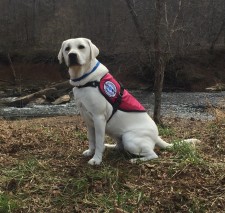Service Dogs by Warren Retrievers Delivers Diabetic Alert Service Dog to Child in Apalachin, NY

Apalachin, NY, March 30, 2017 (Newswire.com) - March 30 is a special day for six-year old Andrew, from Apalachin, NY, as he meets his Type 1 Diabetic Alert Dog delivered by Service Dogs by Warren Retrievers. Andrew’s dog, a Labrador Retriever named “Molly,” has already received thousands of hours of training as a diabetic alert dog and it will continue to learn under the careful guidance of a certified trainer from Service Dogs by Warren Retrievers, “SDWR,” and through the rapport it develops Andrew and his parents, Elizabeth and Joshua. SDWR has a mission to provide specially-bred and trained dogs for adults and children with invisible disabilities like Autism, PTSD, Seizure Disorders, and Diabetes.
Andrew is a very typical six-year old that enjoys riding his bike and playing with his toy construction vehicles or video games. But Andrew also lives with the life-threatening challenges of Type 1 Diabetes. Diagnosed at just three years of age, Andrew only knows daily life with a dozen or more finger-poke blood glucose checks, counting carbohydrate intake, and night-time blood glucose checks by mom and dad. Unlike Type 2 diabetes that can often be controlled with a balanced diet and watching one’s weight, Type 1 is caused when a virus attacks and permanently shuts down a person’s pancreas causing them to need insulin 24 hours a day. Andrew’s diet must contain a careful balance of foods with a special focus on the amount and intake of carbohydrates. Carbohydrates have to be covered by insulin injection or through an insulin pump that is attached to the body delivering insulin through canulas—similar to small IV catheters. Blood glucose levels have to be monitored several times each day and night, as well as after exercise or sleep. Common illnesses like a cold or flu are especially difficult for people with Type 1 as viruses and fevers almost always cause spikes in glucose levels. Blood glucose levels that are too high or too low are life-threatening events for people with Type 1 diabetes. Now with the arrival of the Molly, Andrew will have yet another tool, a four-legged one that has received foundational training to monitor his diabetes.
Dan Warren, Founder and President of Service Dogs by Warren Retrievers, indicates that the Organization’s diabetes alert dogs are trained to recognize and alert on the scent of low and or high blood glucose levels. “When Andrew’s blood glucose begins to fluctuate, his service dog will pick up the scent and give the alert for ‘high’ or ‘low’ blood glucose levels,” states Warren. Often, people may also have hypo or hyperglycemic unawareness—a complication of diabetes in which the person is unaware of a deep drop in blood sugar levels. Andrew has this complication and that along with other factors, made his mother, Elizabeth seek out a diabetic service dog. These hypo and hyperglycemic events, dangerous highs and lows, can result in seizures, coma, and even death. Many Type 1 patients have implanted glucose monitoring systems but these systems are often 20 minutes behind an alert dog’s sense of the glucose movement. Electronic systems measure parts per million while alert dogs have been shown to scent parts per trillion. A trained diabetes alert dog is taught to alert and be persistent to the point where it will go get another member of the household if the dog’s “person” does not respond.
Molly will not only take care of Andrew at home, she will accompany Andrew and his family as they enjoy their favorite activities such as camping and taking trips to the zoo. As a service dog, her right to be with Andrew in all public places is protected under Americans with Disabilities laws. Molly will go with Andrew to restaurants, shopping, to doctors and hospital visits and eventually she may even attend school with him.
Additionally, these amazing dogs are trained to retrieve essentials needed such as Glucose tablets, Glucagon, insulin, juice boxes, testing meters or retrieve medication from a designated spot in the house. Alert dogs are further trained to dial out on K-9 equipped phones to summon emergency medical help if needed. All these trained activities help ease the concern that parents of a young child with Type 1 Diabetes. “There is a great deal of stress and anxiety when caring for Andrew,” says his mother, Elizabeth, “and with the arrival of Molly our entire family feels more calm and secure knowing she will constantly be watching out for him.”
Molly will also work with the SDWR trainers and Andrew’s parents towards public access certification. Dan Warren is quick to point out that, “all the incredible services these dogs can provide are through progression, hard work and dedication of the Organization and the family who must work together to build on diabetic alert dog training foundations and fundamentals. This is about an 18-month training program.”
What sets SDWR apart from other service dog organizations are the customized training methods and SDWR matches dogs to their “person.” According to Dan Warren, “that important bonding time between dog and person can begin to happen right away. For the over seven years we’ve been utilizing this method of dog placement, we’ve achieved amazing results. To date, we have almost 600 dogs working across the country and around the globe.”
Service Dogs by Warren Retrievers is a non-profit organization based in Madison, Virginia, and relies on donations to help the Organization in its mission, “Until there’s a cure…there’s a dog.” To make or donation or learn more about SDWR, please visit the website, http://www.sdwr.org/. To learn more about Diabetic Alert Service Dogs visit http://www.sdwr.org/service-dogs/diabetic-alert/. To find out how you can volunteer or serve as a puppy raiser visit http://www.sdwr.org/volunteer-opportunities/.
Source: Service Dogs by Warren Retrievers
